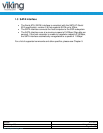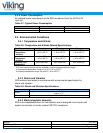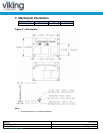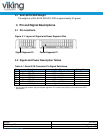
Manual
9/11/2014
PSFEM1xxxGQxxx
Viking Technology
Revision B
Page 15 of 33
www.vikingtechnology.com
2.3.3 Power Consumption
All onboard power requirements of the SSD are derived from the SATA 5.0V
input rail.
Table 2-7: Typical Power Consumption
Mode
Typical
Unit
Active
tbd
W
Idle
tbd
W
2.4 Environmental Conditions
2.4.1 Temperature and Altitude
Table 2-8: Temperature and Altitude Related Specifications
Conditions
Operating
Shipping
Storage
Commercial
Temperature
- Ambient
0 to 70°C
(32 to 158° F)
-40 to 85°C
(-40 to 185° F)
-40 to 85°C
(-40 to 185° F)
Industrial
Temperature
- Ambient
-40 to 85°C
(-40 to 185° F)
-40 to 85°C
(-40 to 185° F)
-40 to 85°C
(-40 to 185° F)
Humidity (non-
condensing)
95% under 55C
95% under 55C
95% under 55C
Notes:
1. SLC flash based products may be available in the following temperature ranges:
a) Commercial temperature range of 0 to 70°C (32 to 158° F)
b) Industrial temperature range -40 to 85°C (-40 to 185° F)
2.4.2 Shock and Vibration
SSD products are tested in accordance with environmental specification for
shock and vibration
Table 2-9: Shock and Vibration Specifications
Description
Shock
50g, 11ms, 3 shocks applied in each direction on 3 mutually perpendicular
axes X, Y, Z
Vibration
16.4g rms 10-2,000 Hz, 3 axes
2.4.3 Electromagnetic Immunity
SSD is an embedded product for host systems and is designed not to impair with
system functionality or hinder system EMI/FCC compliance.


















